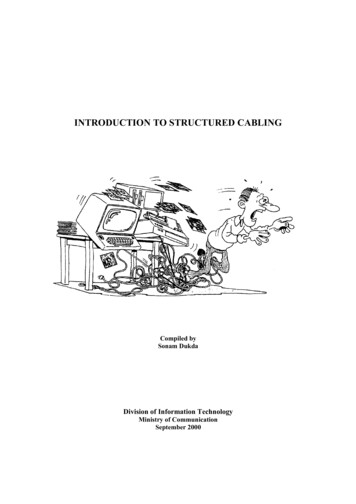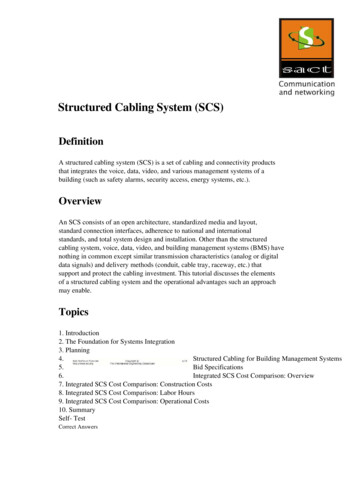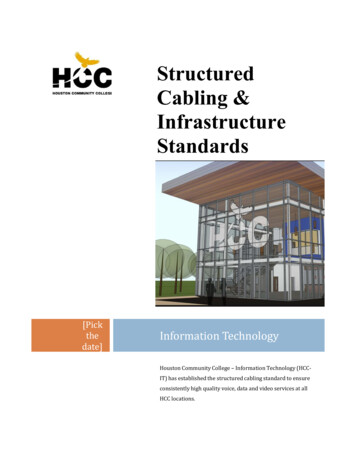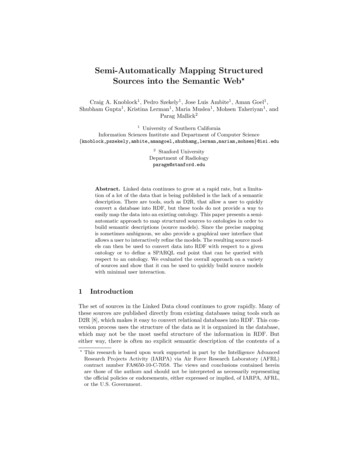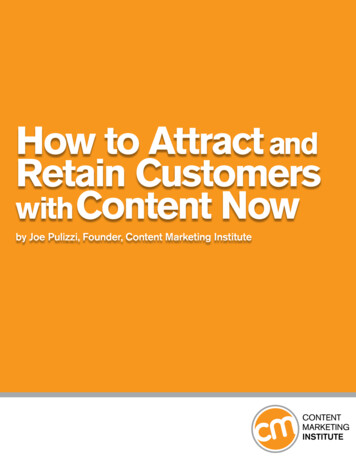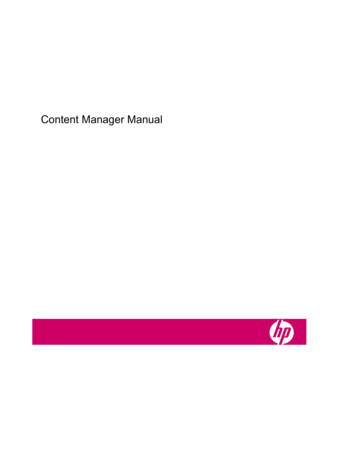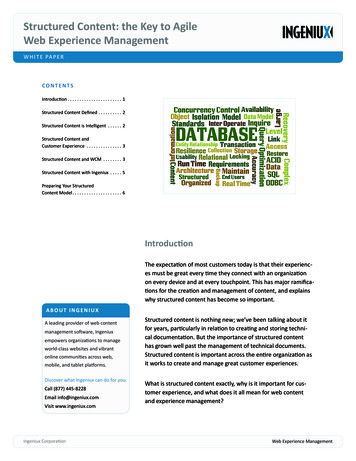
Transcription
Structured Content: the Key to AgileWeb Experience ManagementW H I T E PA P E RCONTENTSIntroduction . . . . . . . . . . . . . . . . . . . . . . . 1Structured Content Defined. . . . . . . . . . . 2Structured Content is Intelligent . . . . . . . 2Structured Content andCustomer Experience . . . . . . . . . . . . . . . . 3Structured Content and WCM . . . . . . . . . 3Structured Content with Ingeniux . . . . . . 5Preparing Your StructuredContent Model. . . . . . . . . . . . . . . . . . . . . . 6IntroductionThe expectation of most customers today is that their experiences must be great every time they connect with an organizationon every device and at every touchpoint. This has major ramifications for the creation and management of content, and explainswhy structured content has become so important.ABOUT INGENIUXA leading provider of web contentmanagement software, Ingeniuxempowers organizations to manageworld-class websites and vibrantonline communities across web,mobile, and tablet platforms.Discover what Ingeniux can do for you.Call (877) 445-8228Email info@ingeniux.comVisit www.ingeniux.comIngeniux CorporationStructured content is nothing new; we’ve been talking about itfor years, particularly in relation to creating and storing technical documentation. But the importance of structured contenthas grown well past the management of technical documents.Structured content is important across the entire organization asit works to create and manage great customer experiences.What is structured content exactly, why is it important for customer experience, and what does it all mean for web contentand experience management?Web Experience Management
STRUCTURED CONTENTWHITE PAPERStructured Content DefinedStructured content is content stored in a format that defines and describes it. This has nothing to do withwhere the content is displayed or how it will look, but is about the type of content it is, using tactics suchas metadata tags or DITA (for more complex structures).Consider the difference between content stored in Microsoft Word and content stored in MicrosoftExcel. In Word, content is entered free form the way the author likes and there are no rules for how thecontent must be written, or a way to explain what the content is about. In Excel, content (or data) is entered into rows and columns with each row and column describing the type of content entered. In otherwords, Excel content is structured and Word content is unstructured.In terms of the Web, traditional Web content is HTML-based, but HTML only describes what the contentlooks like. New approaches to managing Web content provide the structure of the content. This structured content is generally XML, JSON (Java Script Object Notation) or XHTML with additional tag sets anddescribes what the content means.Structured content can be as simple as using RDF (Rich Descriptive Format) to add item scope tags to define if a snippet of HTML is a person or a movie or book, etc, so Google can display and index it properly.Or it can be as complex as using DITA (Darwin Information Typing Architecture) to highly structure thecontent in XML for print and electronic publishing.In the web content management world, most organizations fall in the middle of where they use structured content. They do not go to the full XML object model, but they also do not use an HTML Pagebased model. A middle path to structured content can be as simple as page-based content managementwhere you structure the content within the page for multi-channel reuse.Structured Content is Intelligent ContentStructured content is also known as intelligent content. Intelligent content is a huge topic for marketing,but also is important across the organization and all types of content.Ann Rockley, author of Managing Enterprise Content and founder of the Intelligent Content Conferencedefines1 intelligent content as:“ structurally rich and semantically categorized and therefore automatically discoverable, reusable,reconfigurable, and adaptable.”What this means is that you create content in such a way that there is no relationship to how it’s delivered on a web page, but is structured with tags and categories, and contains metadata about the contentitself. This makes the content easier to find by both humans and machines, and enables you to display itin any number of formats.2Web Experience Management
STRUCTURED CONTENTWHITE PAPERWhy Structured Content is Important to Customer ExperienceAccording to Scott Abel2, the Content Wrangler, there are seven rights to delivering exceptional customerexperiences: ContentPersonPlaceTimeFormatLanguageDevice - actually, device, device, device, device.There are so many channels (website, web application, social, mobile) and devices (tablets, smartphones- iPhone, Android) to provide content to your customers, that it’s impractical, if not impossible, to manage different versions of your content for every one of them. And if that’s impractical, consider howimpossible it would be to create content for every permutation of the seven rights listed above.You need to create your content in such a way that it can be used anywhere – your website, your customer-facing business application, your social networks, a mobile device –create once, publish anywhere.And each channel/device requires content to be displayed differently, whether it’s how the content isformatted or how much of the content is shown.Through the creation of structured, or intelligent, content you have a single source for all your contentrequirements across the organization. Your content isn’t limited to a single purpose, format or technology.Structured content is also adaptable, so you can adapt the content itself based on its surroundings(where and how it’s displayed) and who is looking at it. This is also known as content in context and supports the personalization requirements of customer experience today.Structured Content and Web Content ManagementDelivering structured content as a service fits nicely into the agile, service-oriented environment enterprises need to deliver the cross channel customer experiences demanded today.If we wanted to look at each element of Ann Rockley’s definition of structured content in terms of howit’s supported in a modern Web Experience Management platform, it would look like this:3Web Experience Management
STRUCTURED CONTENTWHITE PAPERStructurally rich. You know exactly how your content is structured, what each piece means in the broader context of the full piece of content.There is no definition of how the content looks, but by structuring the content, you can easily apply different styles to display the content in each channel or device. In a Web CMS you create a content modeland content types to define the structure of your content.Semantically categorized. When taxonomy and metadata are applied to content, the content gets moremeaningful because you add additional information to describe the content that you may not put intothe actual content item itself such as behaviors, processes, rules, structure and descriptive information.In a Web CMS, metadata is applied as content elements (eg. a title is one element of a content type, aname is another) and tags.Other metadata can be workflow or publishing status, language or locale, segment or audience, contentlifecycle information, such as author, data published, expiration date, etc.Structure and metadata models must be consistently applied or machines (like search) will not be able tounderstand and use them properly.Automatically discoverable. Findability is critical for great experiences and is tied tightly to search in webexperience. A search that is based on structured content, a strong taxonomy and metadata supports discoverability of the best content through faceting by category, content type or facets. In addition, a searchbased on structured content can easily pull in different content repositories across the organization todeliver even richer search results.Reusable. When a web experience platform offers the content it manages as a service, integration isgreatly simplified. You can manage any and all content for your website and business systems in yourCMS, and deliver it on demand to whatever front-end interface requests it, whether it’s directly to awebsite built on top of the web experience platform or to a completely separate web application.Reconfigurable. You don’t always want to see a content item the same way every time, so it needs to becreated in a way that enables people and machines to configure it - how much of the content is displayed(eg. the entire product listing or just the Product name and price), if all the same content is displayed(only specific product types or all products sold), the order it’s shown (alphabetically, by date, by author),etc In a Web CMS, faceted search is a great example of configuring content, and navigation is another.Adaptable. We live in a more contextual web environment. Logic may be applied to structured contentat the application layer. Contextual content can be rendered dynamically based audience segments, visitor behavior, devices, business rules, and other factors. In this case structured content supports personalization across multiple channels.4Web Experience Management
STRUCTURED CONTENTWHITE PAPERStructured Content with IngeniuxTo understand better how Ingeniux supports structured content, let’s look at some features and capabilities.Structured content modelIngeniux Web CMS is designed to optimize content reuse. Content is modeled in XML schemas using theIngeniux Schema Designer and natively available as XML or JSON. The content model is very rich and designed to maximize content reuse by structuring content, separating content from presentation, supportfor metadata, and component-based content chunking.Support for content importIngeniux supports the importing of content from a range of sources including DITIA, Scorm, DocBook,Word, custom XML and other sources.Taxonomy, NoSQL database with JSONOne of Ingeniux’s strengths is its taxonomy. It is a powerful tagging and classification system for applyingtopical categories to content. Taxonomy provides browse-by-topic navigation, faceted navigation, guidedsearch, related content, tag clouds, audience segmentation, and other capabilities.Ingeniux’s powerful taxonomy capabilities are powered by its NoSQL database. Ingeniux is the firstenterprise Web CMS based on NoSQL technology, providing a highly scalable, cost effective platform formanaging and delivering content.The NoSQL repository is designed for content. Content is stored as JSON objects and because it does notrequire a fixed schema, any content type can be introduced without development or database changes.The repository supports millions of topics and documents and the content is constantly indexed.Decoupled architectureIf you publish to multiple channels and devices then your Web CMS must support a decoupled architecture. Ingeniux CMS is a decoupled application that replicates content to multiple locations for websiteand content deployment. This means you can publish content to web and mobile sites and applications,external portals, print applications, digital signage, and other emerging channels - the options are wideopen.This decoupled architecture is confirmation of Ingeniux’s ability to create content once, in a structuredformat and then reuse it as necessary.5Web Experience Management
STRUCTURED CONTENTWHITE PAPERDevice library for adaptive targetingIngeniux provides a device profile library of over 20,000 mobile devices. The library is updated weekly toensure you always have support for the latest technology. With this library, Ingeniux is able to detect theuser agent and device requesting content and can deliver content intelligently to each device.Built-in responsive template system and page builderThe Ingeniux Page Builder is a powerful feature that empowers web managers to create or modify pagelayouts without coding or development. Ingeniux natively supports responsive web frameworks likeFoundation and Twitter Bootstrap 3.0, which provide the grids in the Ingeniux visual page builder. WithPage Builder you can click-and-drag to re-size columns, drag-and-drop text, video, images, and contentwidgets onto templates, and manage presentations for multiple channels. Additional responsive frameworks can also be supported.Publishing targets and syncWith its decoupled architecture, Ingeniux supports replication to multiple publishing targets. This includes websites, mobile apps, web applications and so on. Ingeniux supports both early binding to HTMLand other static publishing types, as well as late binding for dynamic content delivery. Replication is bidirectional and can be automated.SearchIngeniux goes beyond traditional search technology with InSite, a search architecture expressly designedfor intelligent content. InSite supports intelligent web search and for querying content sets using semantic structure. Faceted and guided search, integrated taxonomy, security and content filtering are important capabilities of the search engine.API for programmatic access to structured contentAlong with publishing content within the CMS, Ingeniux provides a REST-based API that exposes all Ingeniux functionality. This enables other applications not built on the CMS to access the structured content.Preparing Your Structured Content ModelIt is no small undertaking to design a structured content model, but the benefits far outweigh the timeand effort.You have to take the time to understand all the content your organization creates and manages. Definedetailed content types, including their metadata elements and how they are related to each other. Yourcontent model should be able to describe how your content is created and can be reconfigured andreused.6Web Experience Management
STRUCTURED CONTENTWHITE PAPERIf you are starting from scratch consider working on parts of your content model first. If you have contentthat you know you need to reuse in multiple locations, start defining the structured content model forthose first, and then slowly incorporate additional content.As you develop your structured content model keep in mind the key attributes of structured content:structurally rich, semantically categorized, automatically discoverable, reusable, reconfigurable andadaptable.Remember to look for a Web CMS that offers not only the ability to store structured content, but alsooffers features and functionality to use structured content to create a consistent customer experienceacross all your channels and devices.Footnotes1. Anne Rockley, retrieved 13 July 2015 from -ofcontent-strategy-embraces-content-marketing/2. Scott Abel, retrieved 13 July 2015 from http://thecontentwrangler.com/TA K E T H E N E X T S T E PDiscover what Ingeniux can do for you.About Ingeniux Call (877) 445-8228 to speak with a solutions expertIngeniux empowers organizations to manage world-class Email info@ingeniux.com to request more informationwebsites and vibrant online communities across web, Visit www.ingeniux.com to learn about Ingeniux solutionsas a hosted service (SaaS) or on-premise application.A leading provider of web content management software,mobile, and tablet platforms. Ingeniux software is availableIngeniux delivers unparalleled service and support tocustomers worldwide.7Web Experience Management
Web Experience Management Introduction The expectation of most customers today is that their experienc-es must be great every time they connect with an organization on every device and at every touchpoint. This has major ramifica-tions for the creation and management of content, and explains why structured content has become so important.


